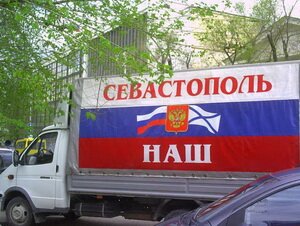
Part 5 “It Nearly Came to War”
Part 4. “Sevastopol - Crimea – Russia”
Part 3. “How the Black Sea Fleet Was Divided “Fraternally”
Part 2. “Black Sea Fleet on the Scales of Political Tender“
Part 1. “The Russian Federation’s Black Sea Fleet and National Security of Ukraine”
Part 6. "At the Peak of the Fleet-Wide Psychosis"
As planned, the elections to the Supreme Council of the Crimea took place in two stages on the 27th of March and on the 11th of April 1994. Despite banning by the President of Ukraine, in parallel with the first round of elections an attempt was made to ask the Crimeans “about their attitude to Ukraine”. Although the results of the survey had no legal effect, Yu.Meshkov and his team considered them a “victory of the Russian idea in the Crimea”, and, by and large, the basis for the creation of their own state in the Peninsula”.
But more important were the results of the second round of the elections, when “Russia” block won, having received 54 out of 94 seats in the Parliament of the Crimea. By the way, bearing in mind that not more than 50 % of the population who had the right to vote, participated in the elections, the victory cannot be called convincing.
However, using its advantage, the Parliamentary faction of the “Russia” block immediately brought to the agenda of the first meeting of the Supreme Council of the Autonomy a question of returning to the 1992 Constitution of the Crimea. That is, they tried to legally justify the separation of the Crimea from Ukraine.
 |
|
“Sevastopol-Crimea-Russia” is calling Crimeans to boycott any elections http://news.allcrimea.net/ |
At the same time, pro-Russian forces of Sevastopol also got activated. Thus, literally the very next day after the Parliamentary elections in the Peninsula, a new political block of ultra-right pro-Russian parties - “Sevastopol-Russia” appears. Leaders of the block, operating under the patronage of the Black Sea Fleet, intended to elect their representatives to the posts of the Mayor of Sevastopol and the Head of the City Council, and thus to make an absolute majority.
Yu.Meshkov himself got busy creating his Security Forces, which were supposed to protect him from the “invasion of Ukraine”. In particular, in April 1994, he issued a Decree on the Personnel Changes in the Security Structures of the Peninsula. Minister of the Inner Affairs of the Crimea was appointed a former Commander of the 32nd Army Corps Kuznetsov, and the Chief of the Security Service of Ukraine in the Crimea - the former Chief of Staff of the Corps V.Lepekhov. True, knowing the imaginary legitimacy of his Decree and fearing an adequate reaction of the Ukrainian leadership, Yu.Meshkov asked activists from “Russia” block to guard his residence in Simferopol. Fulfilling that request, the same day the “Russia” block held a meeting in support of “the President”.
Yu.Meshkov also actively defended the idea of military service for the residents of the Crimea only in the Peninsula, which, in his view, was to increase the loyalty of the Ukrainian military units stationed in the Autonomy.
***
At that moment, the Russia-Ukraine conflict arose because of the “Cheleken” hydro-graphic vessel. Preventing smuggling of naval assets to Russia, Ukraine's leaders rightly blocked individual, located out of the Crimea rear subunits of the BSF.
In the evening of the 10th of April, 1994 Special Forces of the Armed Forces of Ukraine took under control the area of dislocation of the 130th Separate Division of Conservation of Ships of the Black Sea Fleet in Odesa. The operation was carried out under command of the Ukrainian Navy Commander Vice Admiral V.Bezkorovaynyi who was at the time on the “Slavutych” ship in Odessa. During this event, several servicemen of the BSF were arrested as they tried to resist commandos.
In response to these actions, the Black Sea Fleet Commandment, according to its tradition, increased combat readiness of the 810th Separate Marine Brigade. All the BSF warships were ordered to return to the main Sevastopol base. At the same time, on the order of the Commander of the Black Sea Fleet, supply of electricity to the Command Post of the 174th AD Missile Brigade of Ukraine was cut.
The military and political leadership of the Russian Federation did not stay off either. Already on the 11th of April, 1994 leader of the “Party of Russian Unity” faction of the Russian State Duma, S.Shakhray announced the intention of the Russian side “to give an adequate response to the events in Odessa”. The Chief Commandment of the Navy of Russia expressed a protest in connection with the “Ukrainian Special Forces’ assault on the division of conservation ships of the BSF in Odesa”. According to the Press Center of the Russian Navy, “... these provocative in nature and content actions of the Ukrainian side were a direct violation of the achieved agreements and created an explosive atmosphere around the Black Sea Fleet”. Personally from himself, the First Deputy Chief Commander of the Navy of the Russian Federation Admiral I.Kasatonov added that “... Ukraine's unilateral decision to include the Black Sea Fleet base in Odesa into the Ukrainian Navy is an act of planned state terrorism”.
Persuading the subordinate personnel in the correctness of their actions, the Commandment of the BSF connected to this case political structures and Naval officers' meetings, which began building up another anti-Ukrainian psychosis at the Fleet-wide scale.
Thus, on the 13th of March 1994, in the Sailor Club of the BSF a meeting of officers was held with the participation of over 300 representatives of military units, institutions and services of the main base of the fleet in Sevastopol. On the agenda there was the issue of “About the Events in Odesa”, which caused “a great resentment” of all the present.
The Resolution of this meeting was appropriate about mistrust to the Ministry of Defence and the Commander of the Ukrainian Navy Vice Admiral V.Bezkaravaynyi. A new Supreme Council of the Crimea was categorically asked to consider the “appropriateness of the Armed Forces of Ukraine presence in the Peninsula”. The recommendation of the BSF officers to the Deputies of the City Councils of Odessa, Ochakov, Izmail and Nikolayev to consider the events and give them their assessment, looked absolutely indecent. As usual, there were promises to use “adequate retaliatory actions of the Black Sea Fleet”.
Later such officers' meetings took place in units of the Black Sea Fleet, which were attended by representatives of the Supreme Council of the Crimea, pro-Russian organizations of the Peninsula. At these meetings, the Head of the Coordinating Council of Assemblies of the BSF Officers, Captain of the 1st Rank V.Volodin, supported by the Fleet Commandment and some Deputies of the Crimean Parliament, tried to justify the actions of the “Cheleken” inspiring strong anti-Ukrainian moods among the staff of the Black Sea Fleet.
Soon this psychosis spread beyond the Fleet-size, having covered, like metastases, the entire Peninsula, and, above all, - Sevastopol. A special role in this, as always, played the infamous Flag of the Motherland”. Commenting on the events surrounding the 310th Division of the BSF, the newspaper accused Ukrainian commandos of criminal seizure of Russian servicemen and members of their families who were subjected to “moral and physical tortures”. It also declared that in the case of “repeated attacks of Ukrainian gang formations”, The Black Sea Fleet will answer with all its military might.
***
Despite the possibility of an armed conflict between Ukraine and Russia over the hydro-graphic ship “Cheleken”, these events did have a positive factor. In particular, they made the Russian leadership continue negotiations with Ukraine on the Black Sea Fleet in a practical aspect.
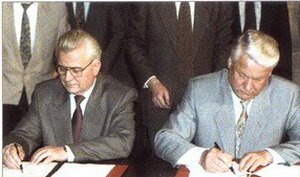 |
|
Left to right: L.Kravchuk, President of Ukraine in 1991-1994 and B.Yeltsin (1931-2007), President of the Russian Federation in 1991-1999. Sighning of the Agreement on a phased settlement of the problems of the BSF Sighning of the Agreement on a phased settlement of the problems of the BSF. http://ursa-tm.ru/forum/ |
On the 15th of April, 1994, after a long delay on the part of the Russians, Russian President Boris Yeltsin and Ukrainian President Leonid Kravchuk signed an Agreement for a phased settlement of the Black Sea Fleet problems. Under this Agreement, Ukraine was to receive 15 to 20% of the ships of the Fleet. It was assumed that basing of the Russian Black Sea Fleet units and the Naval Forces of Ukraine will be separate.
At first, the Black Sea Fleet Commandment seemed to have started fulfilling the Agreement. At least, Commanders of units of the Fleet were ordered to prepare data on the presence of weapons, equipment and logistics in preparation for the upcoming division of the BSF.
In reality, the situation was absolutely different. Demonstrating its willingness to carry out the Agreement with Ukraine, Russia fiercely resisted the process of division of the Fleet, using pro-Russian organizations of the Crimea and Sevastopol.
Thus, with the silent support of the Black Sea Fleet Commandment, authorities of Sevastopol got fiercely involved in the struggle for the “Russian status” of the city as “the main base of the Black Sea Fleet”. In particular, on the19th of April 1994, during a Session of the City Council, together with an assessment of the situation around the incident in Odessa, there was also considered the question of the survey on the status of the city of Sevastopol.
On the first issue, under pressure from pro-Russian Deputies, there was adopted a Resolution which censured the Ukrainian Navy for its confronting the Black Sea Fleet. Besides, in connection with the Decision of the Presidents of Ukraine and Russia on the separate basing of the two Navies, the Navy of Ukraine was offered to leave the territory of Sevastopol.
According to the Deputies of the City Council of Sevastopol, the best solution to the Black Sea Fleet problems were “Massandra Agreements” allegedly suggesting “preserving its unity under Russian jurisdiction, with the main base in Sevastopol”. Apart from this, it was decided to ask the Presidents of Russia and Ukraine to allow a Sevastopol delegation to participate in the Russian-Ukrainian talks on division of the BSF.
|
Note. In September of the same year another meeting at the highest level took place in the Crimean Massandra. The signed at it Protocol on Settlement of Problems of the Black Sea Fleet, instructed “the state delegations of the Russian Federation and Ukraine within a month to work out all the issues related to the development of the Agreement, according to which the entire Black Sea Fleet with all its infrastructure in the Crimea is used by Russia and gets Russian symbology on the understanding that the Russian side will make the appropriate calculations for that half of the Black Sea Fleet, including infrastructure, which in view of previous Agreements would have to go to Ukraine” |
|
Note. “Massandra Summit”. Unexpected Turns. The next meeting of the Presidents over the issue of the Fleet took place on the 3d of August in the Crimean town of Massandra (Yalta). Prior to the meeting, most observers dealing with the theme of Ukrainian-Russian relations, did not expect anything radically new from that Massandra meeting: “.. An extra-schedule meeting is nothing more than an ordinary rendezvous, - wrote in “Nezavisimaya Gazeta”( Independent Newspaper) V. Portnikov - and no one expects impressive results of it”. Indeed, not only to observers, but also to many participants of the negotiations, the results turned out to be unexpected. As the then Speaker of the Crimean Parliament N. Bagrov , who consistently participated in Russian-Ukrainian talks on the Black Sea Fleet, pointed out in his memoirs, “... it all began not with the problems of the Fleet, but with the debt of Ukraine for oil and gas. As it was hard to give convincing answers to the Ukrainian leadership, there appeared an idea- to pay the debts with the part of the Fleet. We all, - writes on N. Bagrov , - were not for this, and L Kuchma, who headed the delegation, said to Viktor Chernomyrdin, that he was not empowered to take such decisions without the President. So the President was invited, and then Boris Yeltsin said he was ready to buy the Black Sea Fleet, and Leonid Kravchuk said that he was ready to sell it“. The sides agreed that a larger part of the Ukrainian half of the Black Sea Fleet will be “bought” by Russia (about 30% of the Ukrainian part). This redemption was associated with energy carriers supplies to Ukraine, however, neither the procedure nor the timing of “buying out” had been mentioned. Only a tentative agreement was achieved, which needed both, qualification and ratification by the two Parliaments. The question of nuclear weapons at the territory of Ukraine was also discussed. It was agreed that Ukraine would give all the nuclear weapons that were at its territory, to Russia for their subsequent destruction for the compensation in the form of fuel for Ukrainian nuclear power plants. The agreement caused a strong reaction, in Russia and Ukraine, and in the world and inspired many contradictory interpretations. Yeltsin told the press that a fundamental Agreement had been achieved, which would solve all the major problems. Defense Minister of the RF Pavel Grachev, at a press conference called Massandra Agreements “fatal”. He said that there had been achieved a fundamental solution to the problems of the Black Sea Fleet, under which the Fleet, Grachev said, “with all its infrastructure in the Crimea will be used by Russia, the ships will carry the Russian flag”.[*] Press Secretary of the Russian President V. Kostikov made it clear that the “triumphal” interpretations of the results of Massandra meeting had mainly inner political sense. The meeting, said Kostikov demonstrated that B. Yeltsin more than nationalists and conservative opposition was able to “realistically and effectively defend interests of ... Russia”. Ukrainian officials were painting a somewhat different picture of what had happened. As Bogdan Nahaylo points out, "According to Kravchuk, no fundamental changes in the Ukrainian position had happened: Ukraine still saw itself as the owner of a part of the Fleet and nuclear weapons at its territory. At the same time, at a press conference on September 6 Kravchuk said that in the negotiations an ultimatum was actually put before the Ukrainian side: either Ukraine finds a way and starts paying off its debt, estimated at around 2 billion US dollars, or Russia cuts oil and gas supplies on which Ukraine depends”. Some Ukrainian commentators accused Russia of “intimidation” and “economic dictatorship” being “beyond civilized methods”. A number of nationalist and national-democratic organizations, in particular Rukh, incriminated Kravchuk even a “betrayal” of national interests. Many Ukrainian politicians spoke in the sense that the Massandra Agreements would never be ratified by the Parliament of Ukraine. Western analysts also very vividly responded to the results of the meeting of the two Presidents. Thus, Bohdan Nahaylo praised the agreement as a “historic event, which means changing the balance of forces in Eastern Europe in favor of Russia and Russia's return to regional superiority, which can have international consequences ...”. As for Ukraine, both, Russian and Western media, according to the same author, estimated its position as “surrender” to the more powerful northern neighbor. As further events showed, some skepticism about these conclusions was not groundless. If the results of Massandra to Ukraine looked like “surrender”, then Russia for its part did not get real benefits. [*] De facto, the Black Sea Fleet, remained Russian anyway, representing a burden rather than a value, especially as the solution of the problem of its basing was not put in motion, and thus in the future all participants of these processes were to face new problems. Whatever like the results of the meeting in Massandra looked in the eyes of the international community, in Sevastopol and in the Black Sea Fleet they were rated at the basis of the lessons of Dagomys, Yalta and Moscow. According to a survey conducted among the BSF servicemen, 65% said they did not believe that the new Agreement would put an end to the question of the Fleet. And they were right, although at first it seemed that the Massandra would add constructivism to the relationship between the Commandement of the Black Sea Fleet and the Navy of Ukraine. Due to persistent demands, the Ukrainian side was forced to change the Commander of its Navy. On the 7th of October, 1993, Rear Admiral Boris Kozhin, just as was the case with his rival Admiral I. Kasatonov, “was promoted” to Kiev, and his place was taken by Admiral Vladimir Beskaravaynyi, a colleague of E. Baltin from the Northern Fleet (other replacements also were made). Since his appointment, both sides hoped that the confrontation would give way to cooperation. A. Malygin. The Crimean Knot http://lib.rus.ec/b/300997/read |
On the second issue the City Council decided to establish a special commission consisting of Deputies of the City Council for the preparation of a survey of Sevastopol citizens. The survey was scheduled for June 26, 1994, and to solve financial problems of the event, it was decided to ask for help the city authorities, directors of leading financial structures, banks and organizations.
So, Yu.Meshkov was not alone in his passion for surveys of all sorts. In fact, this was only natural, taking into consideration the common “roof” of the “President” and his accomplices from Sevastopol. Moreover, the present at the Session of the Sevastopol City Council representative of Yu.Meshkov, urged MPs to support his patron.
The “President” of the Crimea himself suddenly showed an interest in the division of the Fleet, requiring the participation of his representatives at the talks as an authorized party. And he got really annoyed when he got a refusal. According to Yu.Meshkov, such a refusal was “a completely inadequate reaction of the Defence Minister of Ukraine to his legal rights as the President of the Crimean Autonomy”.
To pay back, he again raised the issue of the Ukrainian military presence in the Crimea. All the more so, as in response to the separatist activities of the Crimean authorities, the Ukrainian leadership had really deployed additional military subunits in the Peninsula.
Truly scared of this fact, Meshkov’s supporters began accusing Ukraine of “militarization of the Peninsula”. The main fiddle in the “orchestra” was played by a sham “Committee For Support to the President of the Crimea”, which made a special statement, in which it particularly pointed out “building up the capacity of Ukraine's troops in the Crimea in order to force pressure on the leadership of the Peninsula”. According to the activists of the Committee, “the number of the group of the Armed Forces of Ukraine in the Crimea, was much higher than the required maximum for the time of peace”. Therefore, a protest against such actions of the Ukrainian side was expressed.
The Committee was seconded by the Black Sea Fleet Commander E.Baltin, who used as a loud hailer the Fleet’s newspaper “The Flag of the Motherland”- a true information weapon in a secret fight with Ukraine.
In particular, in his interview to this newspaper on April 19, 1994, he accused Ukraine of three-fold increase in the number of its troops in the Crimean Peninsula, and also expressed support to the political course of Yu.Meshkov. According to E.Baltin, at these regular meetings a wide range of questions was discussed, including the division of the Black Sea Fleet.
E.Baltin traditionally accused Ukrainians of trying to capture the coastal infrastructure, while for some reason requiring to increase the allocation of funds from the budget of Ukraine for the maintenance of the Black Sea Fleet, which looked an absolute absurdity in the situation of his frank ignoring the Ukrainian state. The same requirement was put forward concerning the Black Sea Fleet Hydro-Graphic Systems (by the way, having been vigorously plundered by Russia).
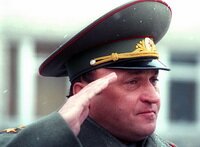 |
|
P.Grachev, Defence Minister of the RF in 1992-1996, Army General http://www.agregator.pro/ |
Meanwhile, the division of the BSF still continued. On the 20th of April, 1994 to regulate the technical aspects, the Minister of Defence of the Russian Federation P.Grachev arrived in Sevastopol.
However, as it turned out, the purpose of the visit was not seeking compromises with Ukraine. It became clear the next day from the speech of the Defence Minister of Russia before the Fleet Commandment. As it was stated by P.Grachev, “... Russia will do its best to keep the Black Sea Fleet for Russia among the most combat capable and productive units of the Armed Forces of the Russian Federation. Besides, Moscow will demand keeping Sevastopol as the main Russian military base on the Black Sea”.
According to Grachov’s speech, Russia would also claim the whole infrastructure of the Black Sea Fleet.
The Russian Minister also encouraged the most distinguished servicemen of the BSF, giving them early military ranks. Among the distinguished there were members of the crew of “Cheleken” hydro-graphic ship, which fact left no doubts as to the real attitude of Russians to Ukraine.
Of course, such a position of the Ministry of Defence of Russia could not help finding a support of the BSF’s Commandment. The latter readily echoed its Minister. In particular, on behalf of the Black Sea Fleet Air Forces, Colonel S.Lobov expressed the pilots’ intention “not to leave Ukraine a single aircraft and without permission to fly away to Russian airfields”.
Russia’s tough confrontation with Ukraine had a direct impact on the course of negotiations on division of the Black Sea Fleet, leaving no chance of achieving positive results in solving the burning issue.
In the first round of talks on the 21st of April, 1994, it became clear that the sides had very different approaches to determining the number of ships in the Black Sea Fleet. In Russia's view, the numbers were significantly lower than those on the lists of Ukraine. That is, the Russian side did not include a part of the ships into the lists for the division of the Fleet.
The question of the temporary basing of the Russian part of ships was not solved from the first attempt either. The Russian Federation did not agree with the proposal of the Ukrainian side to place two naval groups in different bays of Sevastopol.
Settling these issues was left out for the following day, so meanwhile, at the command from Moscow, pro-Russian organizations of the Crimea were trying to make a massive pressure on the Ukrainian delegation and to persuade it to agree to the Russian proposals on the parameters and conditions of the division of the Fleet.
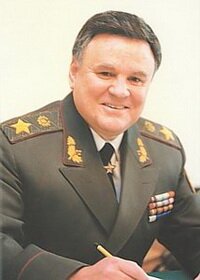 |
|
V.Radetskyi, Defence Minister of Ukraine in 1993-1994, General of the Army of Ukraine http://www.kvoku.org |
Since the first day of talks, Sevastopol television called residents to come to the “people’s meeting” in Nakhimov Square in order to “protect the future of the Black Sea Fleet”. By the time of arrival of the Defence Minister of Ukraine V.Radetskyi and Defence Minister of Russia P.Grachev for the talks, about 200 representatives of pro-Russian organizations of Sevastopol, with the Deputy of the Crimean Parliament A Kruglov at head, had gathered near the Headquarters of the BSF. They put pickets under the slogans for the sole Black Sea Fleet with its main base in Sevastopol. There were placards with open insults of the Ukrainian leadership.
“President” of the Crimea Yu.Meshkov was also busy at the meeting, insisting on his admission to the talks. However, despite the fierce support of this idea by A.Kruglov and his team, Yu.Meshkov was not let to the Headquarters of the Black Sea Fleet.
On the 22nd of April, 1994 under the cries of protesting “Kruglov’s team” near the Headquarters of the BSF, the Commission continued its work on the division of the Fleet. After a discussion, an Agreement on the Quantitative Parameters of the Division of the Fleet was achieved. Out of 883 ships and vessels, Russia was to get 669 (85%), and Ukraine - 164 (15%). At this, for 255 ships of the BSF Russia had to pay a compensation to Ukraine.
But the question of basing of the two navies was not settled. Ukraine insisted on placing its Navy’s Headquarters in Sevastopol, and did not exclude basing of its ships there. The Russian delegation insisted on basing in Sevastopol up to 70% of the forces of the Russian Black Sea Fleet, and on removing all the Ukrainian ships from there. In addition, Russia claimed also to other places of basing of the Black Sea Fleet, in which it was going to dislocate the remaining 30% of ships which now belonged to Russia. In particular, up to 7% of the Russian part of the Fleet were supposed to remain in Donuzlav, 7% - in Feodosia and 5% - in Kerch.
In a word, the appetites of Russia were great, and they almost did not leave any room for Ukraine in the Peninsula.
True, the firm position of the Ukrainian delegation at the talks broke down those plans, which caused an extremely angry reaction of the Russians. Speaking to journalists after the meeting, the Minister of Defence of Russia P.Grachev bluntly accused Ukraine of “actual disruption of the negotiation process”.
Russian President Boris Yeltsin also blamed Ukraine. Through his Spokesman V.Kostikov, he expressed a concern that “Ukraine openly demonstrated its unwillingness to comply strictly with the provisions of the reached in Moscow Agreements on separate basing of Russian Black Sea Fleet and the Ukrainian Navy”. Due to these circumstances, B. Yeltsin promised to conduct appropriate consultations with the “competent authorities of Russia”.
***
Inspired by the success in the elections, Deputies of the new Supreme Council of the Crimea form the leadership of the highest legislative body of the Peninsula. By the way, quite an “expected unexpectedness” was the split of the “Russia” electoral block because of the personal ambitions of its political leaders. As it was supposed, the number of Deputies, having hardly stepped over the threshold of the Supreme Council of the Autonomy, changed their positions.
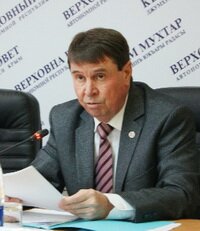 |
|
S.Tsekov, the leader of the “Russian Party of the Crimea” http://russ-edin.org/ |
This mainly concerned the election of the Speaker of the Crimean Parliament, due to a few candidates suggested by a once sole unit, “Russia”. In particular, these candidates were the leader of the “Russian Party of the Crimea” S.Tsekov, as well as A.Kruglov and V.Klichnikov. A serious rival to these candidates was a leader of the Crimean Communists A.Grach.
With the support of the Deputies from Sevastopol, on the 10th of May, 1994 S. Tsekov was elected Speaker of the Crimean Parliament. He immediately got involved in a large-scale Anti-Ukrainian campaign. In his very first speech before the Members of the Parliament, S.Tsekov called for the restoration of the Crimean Constitution from May 6, 1992, to introduce the institute of the Crimean and to demilitarize the Peninsula. The latter concerned only the Law Enforcement structures of Ukraine at the Crimean territory. In the economic sphere S.Tsekov was for the Crimea’s independent financial and customs policy, and for giving the Autonomy all the ownership on land and means of production.
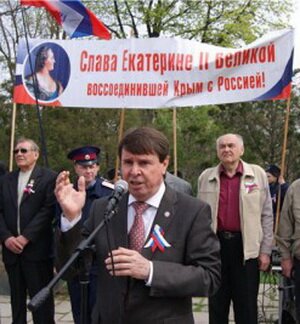 |
|
S.Tsekov at the meeting devoted to the 229th anniversary of the Crimea’s joining Russia. 19.04.1994 |
The next day, May 11, the Supreme Council of the Crimea continued its work. There were elected Deputies of the Speaker of the Parliament, Heads of the 12 Commissions, 8 of whom were supporters of Yu.Meshkov. In particular, the Head of the Commission on Military Affairs, was elected Colonel of the Air Forces of the Black Sea Fleet M.Kukushkin, who immediately expressed an intention in the nearest future to consider the establishment of the National Guard of the Crimea.
Other MPs from the “Russia” electoral block also demanded inclusion into the agenda of the Session of the Supreme Council of the question of “state independence of the Crimean Autonomy”.
Based on these requirements, a list of questions for the next Plenary Session of the Parliament was made. As expected, the most important of them were “the renewal of the Constitution of the Crimea from May 6 1991”, “ the establishment of citizenship of the Autonomy”, and “the division of powers between the Crimea and Ukraine”. All this was soon to form a legal basis for tearing the Crimea away from Ukraine.
There was also raised a question of the transfer of the capital of the Crimea from Simferopol to Sevastopol, where the positions of pro-Russian organizations were particularly strong, and which, unlike the Central part of the Peninsula, was under the general control of the Black Sea Fleet.
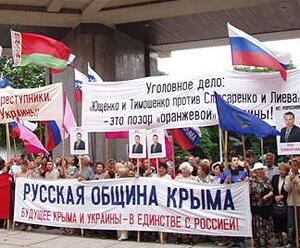 |
| A meeting of the Russian Community of the Crimea near the walls of the Crimean Parliament,2005 http://ru.wikipedia.org/ |
Of course, such measures of the Crimean Parliament got the approval of their Moscow colleagues and patrons. Present at the session Deputy of the State Duma of Russia V.Zatulin promised a “full support to the people of the Crimea and its President”, and shared his plans for creation (out of the Members of the Crimean and Russian Parliaments) of a Bilateral Parliamentary Commission. About the nature of this support one can judge by the words of the Deputy Head of the Russian Federation Council R.Abdulatipov, said on his return to Moscow from Sevastopol, where he took part in the celebration of the Victory Day on the 9th of May, 1994. Thus, in his interview to Russian media, he openly declared the possibility of a serious conflict between Ukraine and Russia over the Crimea and the Black Sea Fleet.
***
Meanwhile, a conflict was brewing in the Supreme Council of the Peninsula itself. As usual, it was caused by banal division of posts in the leadership of the Parliament. Due to some contradictions, some Deputies left the “Russia” faction, having motivated their decision by “immoral secret struggle between different factions within it”.
The “President”of the Crimea Yu.Meshkov failed to put together the administration which would ensure effective work on implementation of the separatist political course of the leadership of the Peninsula. Formation of the Presidential branch of the power in the Crimea had been hampered by financial problems and lack of qualified personnel.
At the same time there was preparation for the elections of the Mayor of Sevastopol. The main role in this process was played by the “Sevastopol – Russia” ultra-chauvinistic political block, that tried to capture most of the key positions in local government bodies of the “City of Russian Glory”. And it had every chance to reach its goal, especially because contradictions in the “Russia” block were clearly seen in its Sevastopol office. Part of its representatives insisted on electing as Mayor of Sevastopol, a Colonel of the Air Forces of the Black Sea Fleet, Member of the Supreme Council of the Crimea A.Melnikov. Opponents of the candidate were not happy with his pro-Yeltsin position, and his active collaboration with A.Kruglov who supported A.Rutskoy and R.Hazbulatov.
The Black Sea Fleet Commandment nominated as its candidate to the post of the Mayor of Sevastopol a notorious Rear Admiral A.Penkin. Most likely, in the Navy’s environment, there was no consensus on who should represent the interests of the Black Sea Fleet in the City Government. Of course, the candidature of the Rear Admiral was more preferable. It is in favour of A.Penkin that signatures were collected in units and subunits of the Fleet. “Sevastopol-Russia” block also was supporting A.Penkin, as was the Committee of War Veterans and the collective of the 13th Shipyard.
***
Meanwhile, the process of preparations for the second round of negotiations on the division of the Black Sea Fleet was gathering momentum. In the context of the events attention was drawn to a new tactics of the Russian side, recommendations of the “competent organs of Russia” could be easily spotted.
In particular, military collectives of the BSF were involved in the division of the Fleet, which had to demonstrate to Ukraine the unity of the BSF Commandment with its subordinates. And, of course, to help to solve the problem on favourable for Russia terms.
One example of such an approach of the Russian side, was the “Appeal of the Servicemen of the 116th Brigade of River Boats” to the President of the Russian Federation Boris Yeltsin, Russia's Defence Minister P.Grachev, the Commandment of the Russian Navy and that of the Black Sea Fleet on the necessity to maintain the sole BSF. In case of transfer of the Brigade to the Ukrainian Navy, its personnel promised to leave the place of its dislocation in Izmail on board their boats.
Another component of the new tactics of Moscow was an attempt to justify the appropriateness of basing the Ukrainian Navy in any other place, but not in the Crimea and Sevastopol. On the 29th of April, 1994 at the Headquarters of the Black Sea Fleet there was held a meeting of the Commander staff of the Fleet in order to develop guidelines for the preparation of documents for the forthcoming negotiations on the division of the Fleet’s infrastructure. Heads of departments and divisions of the Black Sea Fleet Headquarters received an order to develop forms of basing points in Izmail, Odessa, Ochakov, Nikolaev and Kherson on the basis of their representation as the best locations for the deployment of the Ukrainian Navy in terms of “being up to the proportions of the division of the BSF”. At this, an absolutely swindler’s step was created, when as part of the Fleet’s division, Ukraine’s own warehouses, located in these areas, were supposed to be passed over to it. For the simple reason that these stores (by the way, belonging to other branches of the Armed Forces of Ukraine) had been keeping some Naval assets.
Besides, obviously suffering from “selective sclerosis”, the Black Sea Fleet Commandment somehow “forgot” to include into the plan of division some military bases in the Crimea, in particular, the point of basing of submarines in Sevastopol. The same applies to the point of basing of surface ships in Kerch, the form for which was not developed at all. On the other hand, in the preparation of the forms of communication centres of the BSF, they took into account everything, including written off equipment, which was planned to be passed over to Ukraine.
 |
|
TY-22, a long distance supersonic bomber with the changeable geometry of the wing, cruise missile carrier http://militaryrussia.ru/ |
Widely were used tested methods of sending most valuable assets of the Black Sea Fleet to Russia. In early May 1994, the Russian side tried to send to Russia under the cover of tactical flight trainings about 20 Tu-22 from the5th and 942nd Regiments of the Naval Missile-Carrying Aviation. Only the timely reaction of Ukraine did not allow to do so.
By the way, it was the property of the Fleet that was the main “coin” with which the Black Sea Fleet Commandment was paying Sevastopol City Council (and, in fact, its individual members) for support of its position in the negotiations with Ukraine. One of such “tidbits” were the Piers of the 14th Submarine Division of the Black Sea Fleet.
An interesting move in this so-called Fleet game was increase of salaries of the Black Sea Fleet servicemen that had to demonstrate the benefits of their service before the service in the Ukrainian Navy. Since April 1994, the allowance of the BSF servicemen was allocated according to the norms established by the Law of the Russian Federation with recalculation in the national currency of Ukraine. Taking into consideration that at the time these norms were 3-4 times higher than in the Armed Forces of Ukraine, this approach was indeed a significant factor in confirming the Russian idea of a sole Black Sea Fleet.
***
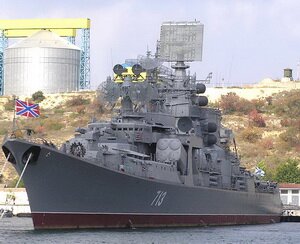 |
|
A large anti-boat ship “Kerch” http://flot.sevastopol.info/ |
Gradually some “special” interests of Russia concerning the Black Sea Fleet were becoming obvious. Among other things, they were interested in commercial use of some objects of the BSF.
Thus, on the 16th -19th of April, 1994, a delegation of the Ministry of Defence of the People's Republic of China of 24 people was visiting the Crimea.
They studied the organization of the educational process and the training base of the Kacha airfield. The guests also visited a large anti-submarine ship “Kerch” and got acquainted with anti-submarine helicopters K-25PL. The possibility of signing an agreement between Russia and China on training Chinese helicopter pilots at the airfield of Kacha and buying anti-submarine helicopters of this type for the Navy of China, was considered.
At this, Russia and China somehow “overlooked” the fact that the airfield was at the territory of Ukraine. If nothing else, the rules of good taste demanded that the discussed questions should have been previously coordinated with Ukraine. Involuntarily an analogy from the depths of history springs to mind of Chinese “volunteers” who served in the Red Army during the Civil War in Russia, and, by the way, participated in fighting against Ukraine at the territory of ... the Crimea.
 |
|
Anti-boat helicopter of ship basing Ka-25 ПЛ http://www.rusarmy.com/ |
***
Against this background, the media of the BSF of the RF continued to widely comment on issues of the division of the Fleet, of course, supporting the position of the Russian side. In early May 1994, the newspaper “The Flag of the Motherland” published another interview with the Deputy Commander of the Black Sea Fleet, Vice-Admiral A.Frolov, in which he especially emphasized the “temporary dual subordination of the Fleet”. In his opinion, the Russian Black Sea Fleet had to be “the main guarantor of peace and stability in the Crimea”. Therefore, as a Member of Parliament of the Crimea, A.Frolov promised to form the necessary legislation base in the Supreme Council of the Autonomy.
In particular, such a “Law” was supposed to regulate presence of the Ukrainian and Russian troops in the Crimea, and subsequently, in fact, of the Crimean armed formations of the so-called “National Guard of the Crimea”.
At this, A.Frolov justified such a position by “weakness of Ukraine” and its “non-viability as an independent state”, the evidence of which was called “the complete collapse of the shipbuilding industry of the Crimea within the two years of Ukrainian independence”.
Based on this, the best solution for the Black Sea Fleet A.Frolov considered its conditional division at 50 : 50 principle with further transfer of the Ukrainian part of the Black Sea Fleet to the Russian side as compensation for Ukraine’s gas debts. According to the Russian Admiral, this approach would allow to avoid some virtually unsolvable problems connected with the inability to divide the military infrastructure of the BSF, including communication, warning, monitoring, data collection, processing and use of information.
A.Frolov also touched upon the issue of basing of power structures of Ukraine in the Crimea. According to him, “... most of the actions of the Ministry of Defense of Ukraine caused too much tension in the Peninsula” However, a special concern of the Deputy Commander of the Black Sea Fleet was the “militarization of the Crimea by Ukraine”. In support of this he mentioned data that already about 60,000 Ukrainian servicemen were already at the territory of the Crimea, and Ukrainian Marine Battalions were dislocated all over the Peninsula.
Besides articles of its own Commanders, “The Flag of the Motherland” published calls of military collectives from other fleets of the Russian Federation, as well as of the “concerned” about the future of the Black Sea Fleet.
In particular, one of such publications was the Appeal of servicemen of the Northern Fleet of Russia, in which they, in insulting manner, accused the Commander of the Ukrainian Navy of the “political conjunction”, “provocations” as well as of “fratricide” and “bloodshed”.

